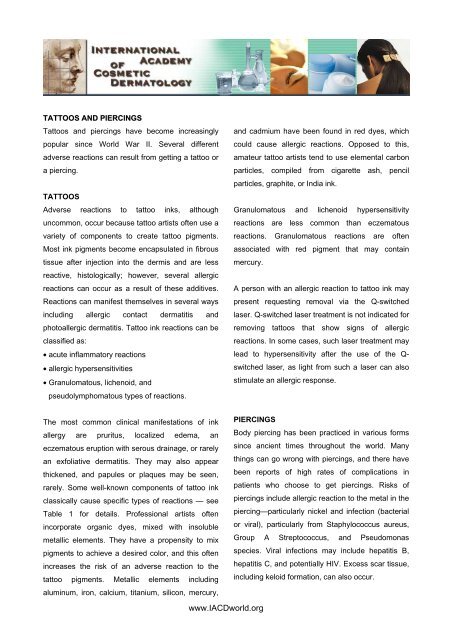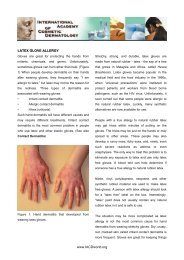To print, please download this PDF file.
To print, please download this PDF file.
To print, please download this PDF file.
You also want an ePaper? Increase the reach of your titles
YUMPU automatically turns print PDFs into web optimized ePapers that Google loves.
TATTOOS AND PIERCINGS<br />
Tattoos and piercings have become increasingly<br />
popular since World War II. Several different<br />
adverse reactions can result from getting a tattoo or<br />
a piercing.<br />
TATTOOS<br />
Adverse reactions to tattoo inks, although<br />
uncommon, occur because tattoo artists often use a<br />
variety of components to create tattoo pigments.<br />
Most ink pigments become encapsulated in fibrous<br />
tissue after injection into the dermis and are less<br />
reactive, histologically; however, several allergic<br />
reactions can occur as a result of these additives.<br />
Reactions can manifest themselves in several ways<br />
including allergic contact dermatitis and<br />
photoallergic dermatitis. Tattoo ink reactions can be<br />
classified as:<br />
• acute inflammatory reactions<br />
• allergic hypersensitivities<br />
• Granulomatous, lichenoid, and<br />
pseudolymphomatous types of reactions.<br />
and cadmium have been found in red dyes, which<br />
could cause allergic reactions. Opposed to <strong>this</strong>,<br />
amateur tattoo artists tend to use elemental carbon<br />
particles, compiled from cigarette ash, pencil<br />
particles, graphite, or India ink.<br />
Granulomatous and lichenoid hypersensitivity<br />
reactions are less common than eczematous<br />
reactions. Granulomatous reactions are often<br />
associated with red pigment that may contain<br />
mercury.<br />
A person with an allergic reaction to tattoo ink may<br />
present requesting removal via the Q-switched<br />
laser. Q-switched laser treatment is not indicated for<br />
removing tattoos that show signs of allergic<br />
reactions. In some cases, such laser treatment may<br />
lead to hypersensitivity after the use of the Q-<br />
switched laser, as light from such a laser can also<br />
stimulate an allergic response.<br />
The most common clinical manifestations of ink PIERCINGS<br />
allergy are pruritus, localized edema, an Body piercing has been practiced in various forms<br />
eczematous eruption with serous drainage, or rarely since ancient times throughout the world. Many<br />
an exfoliative dermatitis. They may also appear things can go wrong with piercings, and there have<br />
thickened, and papules or plaques may be seen, been reports of high rates of complications in<br />
rarely. Some well-known components of tattoo ink patients who choose to get piercings. Risks of<br />
classically cause specific types of reactions — see piercings include allergic reaction to the metal in the<br />
Table 1 for details. Professional artists often piercing—particularly nickel and infection (bacterial<br />
incorporate organic dyes, mixed with insoluble or viral), particularly from Staphylococcus aureus,<br />
metallic elements. They have a propensity to mix Group A Streptococcus, and Pseudomonas<br />
pigments to achieve a desired color, and <strong>this</strong> often species. Viral infections may include hepatitis B,<br />
increases the risk of an adverse reaction to the hepatitis C, and potentially HIV. Excess scar tissue,<br />
tattoo pigments. Metallic elements including including keloid formation, can also occur.<br />
aluminum, iron, calcium, titanium, silicon, mercury,<br />
www.IACDworld.org
When removed, piercings may leave a hole or scar.<br />
Edema and delays in healing can result from<br />
trauma such as tearing, friction, or bumping of the<br />
piercing site. Oral trauma, including recession of<br />
gingival tissue and dental fracture and wear, can<br />
result from lip and/or intra-oral ornaments.<br />
It is important for people to select a piercing studio<br />
that complies with proper hygiene and autoclaving<br />
of instruments between patients to minimize these<br />
risks.<br />
Ravneet Ruby Kaur, BSN, MD<br />
Los Angeles, CA, USA<br />
Table 1 – COMPOSITION OF TATTOO PIGMENTS<br />
Tattoo Ink<br />
/ Pigment<br />
Color<br />
Ingredient Comments and Relevant Information<br />
Black<br />
Brown<br />
Red<br />
Yellow<br />
Green<br />
Blue<br />
Violet<br />
(purple)<br />
Iron Oxide<br />
Carbon<br />
Logwood<br />
Ochre (Ferric<br />
oxide)<br />
Cinnabar<br />
/Mercuric sulfide<br />
Cadmium Red<br />
Iron Oxide/<br />
Common Rust<br />
Napthol-AS<br />
pigment<br />
Cadmium Yellow<br />
Ochres<br />
Curcuma Yellow<br />
Chrome Yellow<br />
(PbCrO4, often<br />
mixed with PbS)<br />
Chromic oxide<br />
(Casalis Green or<br />
Anadomis Green)<br />
Lead chromate<br />
Phthalocyanine<br />
dyes<br />
Ferrocyanides<br />
and<br />
Ferricyanides<br />
Azure Blue<br />
Cobalt Blue<br />
Copper<br />
phthalocyanine<br />
Cobalt aluminate<br />
Manganese<br />
ammonium<br />
pyrophosphate<br />
• Natural black pigment is made from magnetite crystals, powdered jet,<br />
bone black, and carbon.<br />
• India ink is often made of black pigment from carbon.<br />
• Logwood is extracted from Hematoxylon campechisnum in Central<br />
America and the West Indies.<br />
• Rarely are black tattoo pigments associated with allergic reaction.<br />
• Amateur tattoos are frequently black and thus less commonly cause<br />
allergic reactions.<br />
• Ochre is composed of ferric oxides mixed with clay.<br />
• Heated ochre changes from yellow to a red hue.<br />
• Most commonly reactions occur to red pigments that may be caused by<br />
a variety of components, especially mercuric sulfide (cinnabar). Often<br />
these are lichenoid reactions.<br />
• Cinnabar and cadmium pigments are toxic.<br />
• Naphthol red is least reported to cause reactions.<br />
• In 1976, the Food and Drug Administration limited mercury in tattoo<br />
dyes to 3 ppm. Despite <strong>this</strong> restriction, allergic reactions to the red<br />
pigments still occur (28).<br />
• Patch testing for mercuric chloride may show a positive reaction but is<br />
not reliable for cinnabar.<br />
• Yellow pigments rarely cause reactions, but will more often cause a<br />
photo-aggravated/toxic reactions due to cadmium sulfide (a light-sensitive<br />
material), leading to edema and erythema.<br />
• Red tattoos sometimes have a cadmium additive used to brighten the<br />
red pigment; these have also been associated with photo-aggravated<br />
reaction.<br />
• Curcuma is derived from tumeric or curcurmin.<br />
• Greens pigments may be mixtures, such as potassium ferrocyanide<br />
(yellow or red) and ferric ferrocyanide (Prussian Blue).<br />
• Allergies to green and light-blue pigments are less common but when<br />
they do occur they are often related to chromium, aluminum or chloride<br />
cobalt additives.<br />
• Chromium has been associated with local eczematous reactions, hand<br />
eczema and generalized eczematous eruptions.<br />
• Patch testing may be positive for 0.5% potassium dichromate.<br />
• Blue pigments from minerals include copper carbonate, sodium<br />
aluminum silicate (lapis lazuli), calcium copper silicate (Egyptian Blue),<br />
other cobalt aluminum oxides and chromium oxides.<br />
• The blues and greens least likely to cause allergic reaction contain<br />
copper pthalocyanine which is more stable than cobalt and are FDA<br />
approved for use in contact lenses, infant toys and furniture.<br />
• Some purple pigments, particularly bright magentas are photo-reactive<br />
and lose their color after prolonged exposure to light.<br />
• The most stable purple pigments contain dioxazine and carbazole.<br />
www.IACDworld.org
White<br />
Henna<br />
Various<br />
aluminum salts<br />
Dioxazine/carbaz<br />
ole<br />
Lead Carbonate<br />
Titanium dioxide<br />
Barium Sulfate<br />
Zinc Oxide<br />
Henna dye and<br />
paraphenylenedi<br />
amine (PPD)<br />
• White pigment may be used alone or to dilute the intensity of other<br />
pigments.<br />
• There are no described allergic reactions to titanium oxides, thus<br />
making them one of the least reactive white pigments.<br />
• Temporary henna tattoos create a brownish stain to when henna dye is<br />
painted onto the skin.<br />
• Henna itself is safe.<br />
• PPD, a common industrial allergen, is often mixed into temporary henna<br />
tattoos and can cause a contact dermatitis. It is also used as a textile dye.<br />
www.IACDworld.org




